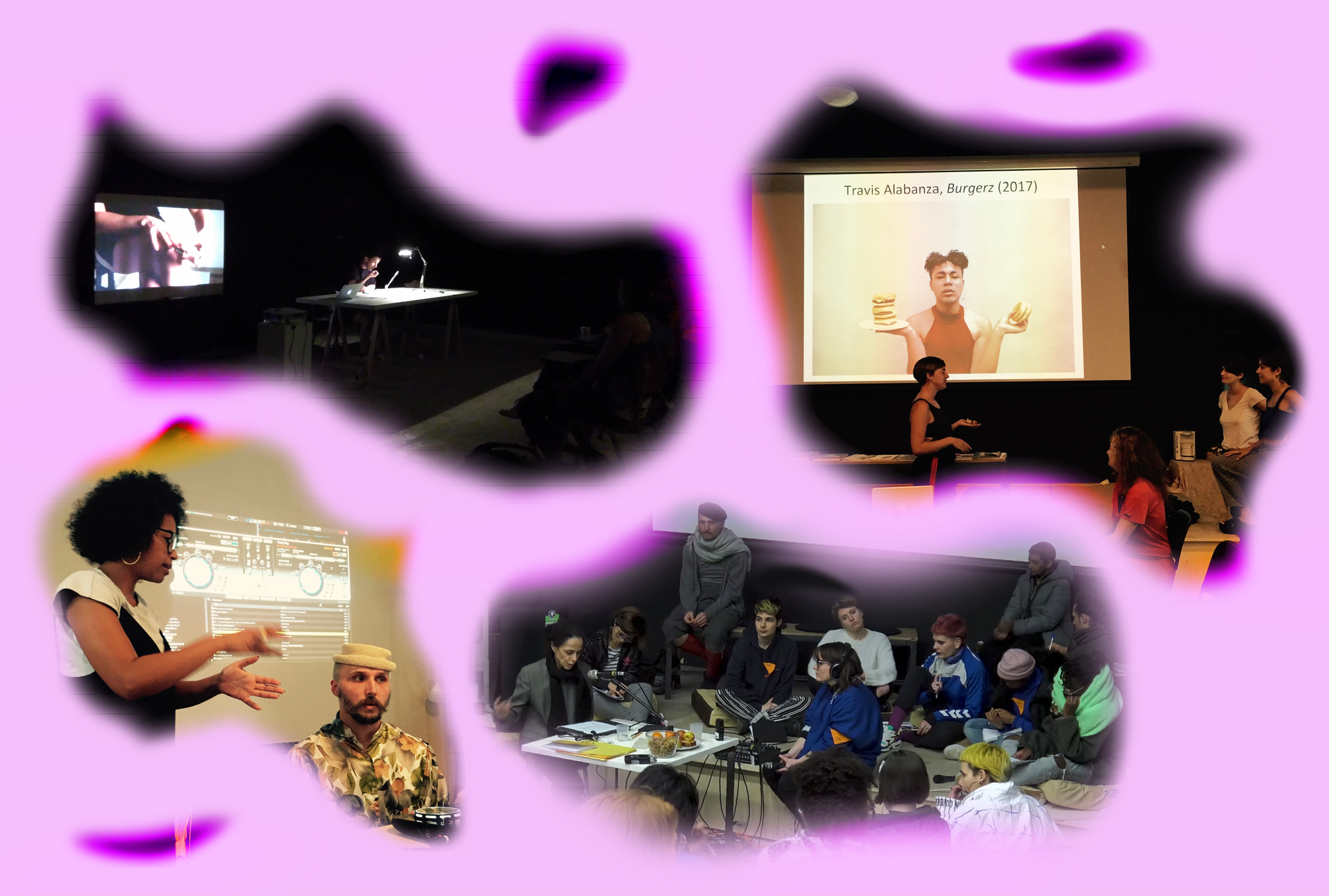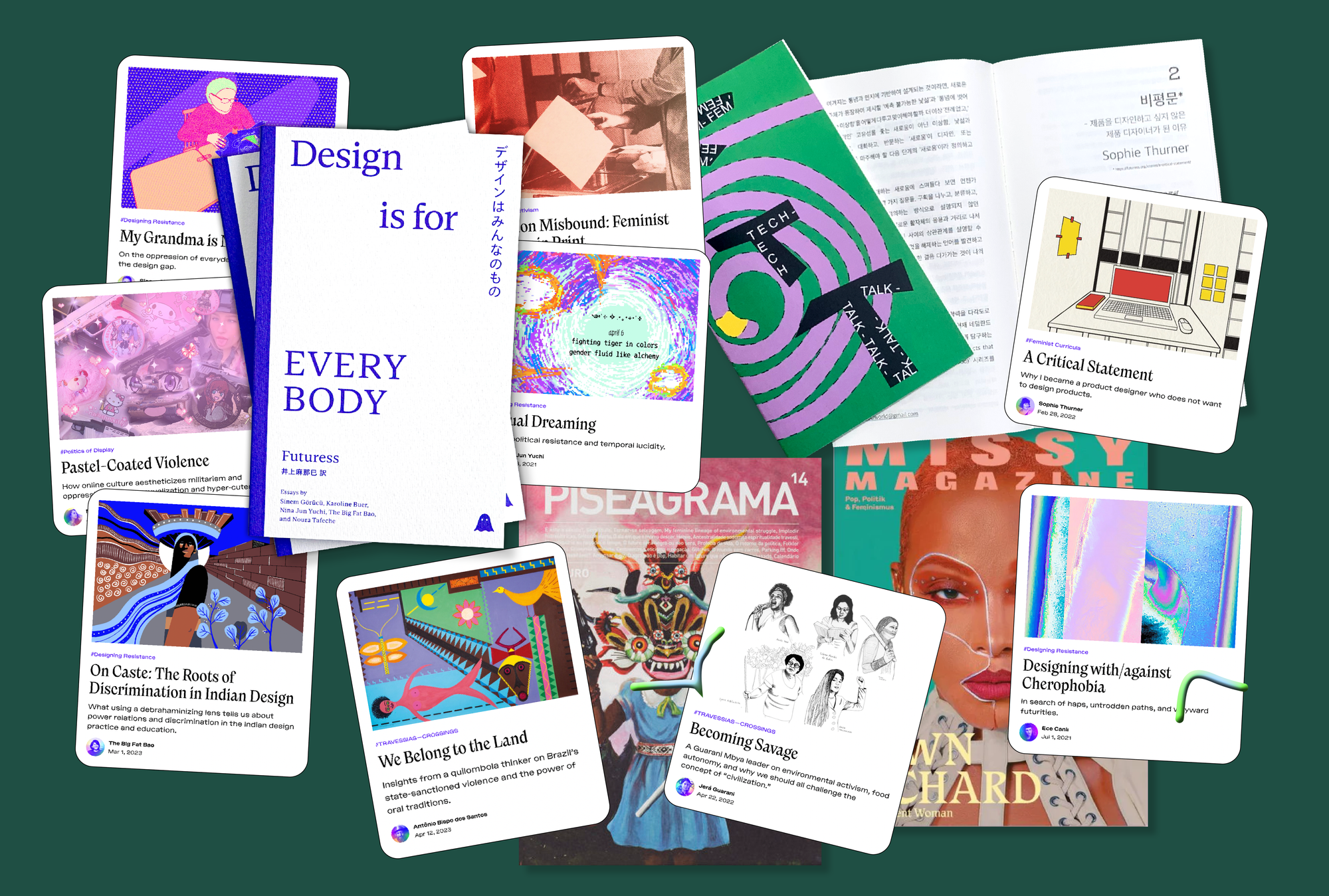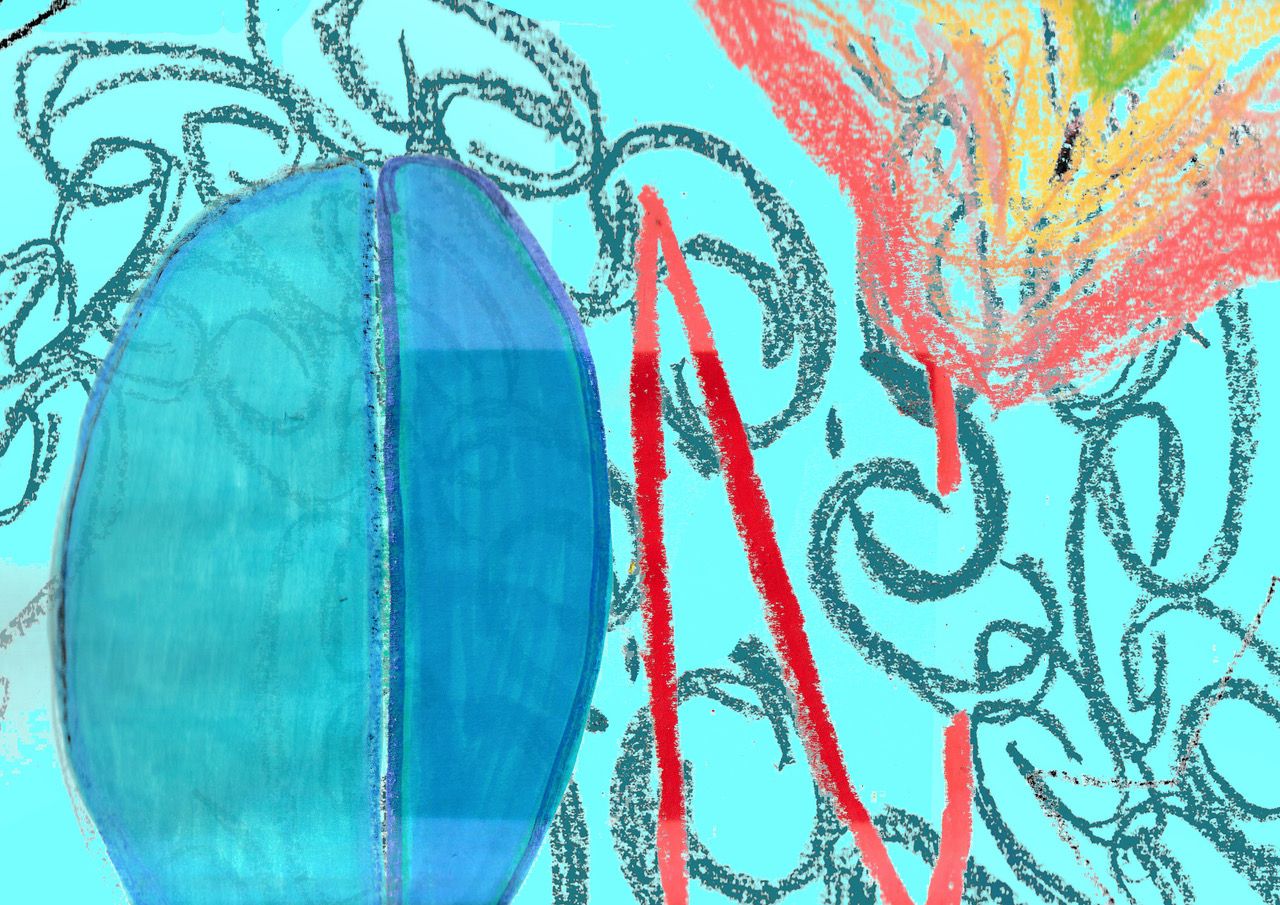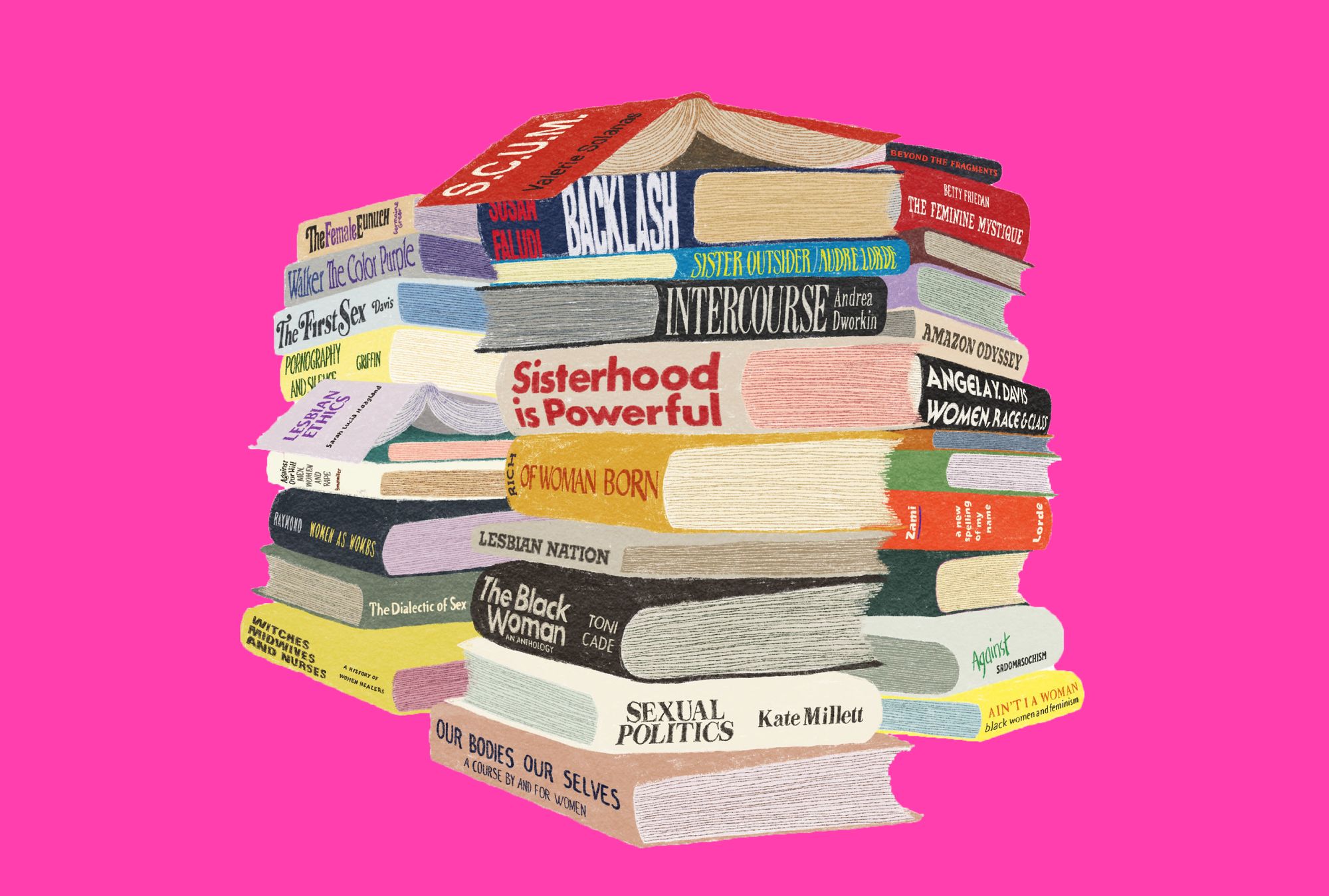
It’s an early January morning, and I’m in my pajamas, scouring the internet for a book I’ve long desired: Rolling Our Own: Women as Printers, Publishers and Distributors. Unfortunately, none of my usual second-hand online book dealers seem to have it, but my search eventually leads me to a light pink website called Frauenkultur. My mind is instantly blown away: not only do I get a tiny sneak peek at the 1981 Minority Press Group book I crave for my shelf, but the website—a second wave feminist reading archive—sets me off on a journey of curated wonders.
Frauenkultur is a project by Bec Wonders, a polymath artist, writer, activist, and researcher, who recently completed her PhD titled ‘Please Say More’: mediating conflict through letter-writing in British second wave feminist periodicals. She started Frauenkultur while doing her PhD, as a way to circulate academic research in a more accessible and engaging way. I shoot her a quick message, she instantaneously replies, and our communication starts.
Bec Wonders is a wanderer. She was born in Sweden, grew up in Germany, did her undergraduate and master’s degrees in Canada, and currently lives in the UK. She inherited her love for typography and print from her grandmother Lillian Paradise Wonders, who had her own printing press in her garage. As a high school student in Uppsala, Bec made and sold her own clothes. But the fashion business seemed too daunting, so she then ventured into the arts—though fabric remained her medium of choice. But art also wasn’t enough, so she decided to pursue a second degree in art and philosophy. Although she regrets pursuing two courses at the same time—“humanly unmanageable,” she laments—Bec certainly has a penchant for weaving multiples.
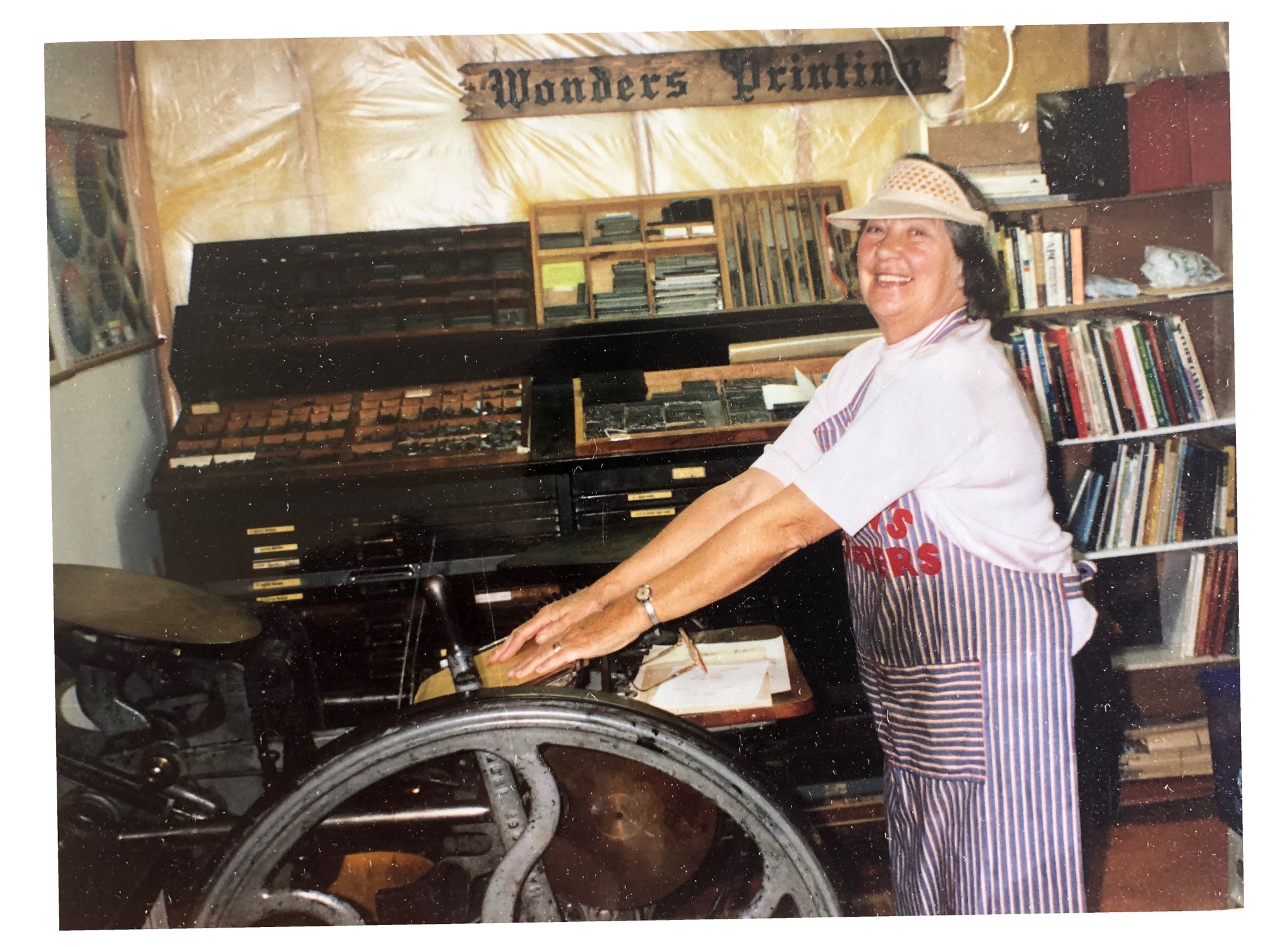
In 2017, she enrolled in a Master’s of Publishing at the Simon Fraser University in Vancouver, Canada. Out of all of her studies, she found publishing to be the most useful, as it opened up her consciousness to how the book and the magazine industries work, and also led her to discover all the feminist archival material that has since become her focus and passion. While studying publishing, she co-founded the Vancouver Women’s Library. In the following conversation, we talk about libraries as systems of knowledge and empowerment among communities, the importance of conflict in feminist contexts, and much more.
Nina Paim: First of all, how did the Vancouver Women’s Library come into being?
Bec Wonders: It emerged from a group of friends. Many of us came together through local activism, and being involved or knowing women who were volunteering at the local women’s shelter. Many of us had personal libraries with lots of feminist texts which were hard to come by, so we just started lending them to each other. At one point we realized we should start a library, because in a way, we were already running one.
I had a little artist’s studio on the east side of Vancouver, where I was doing weaving and textile work, and we transformed it into a mini library with around 80 books. From there, it really took off and became quite big—possibly bigger than any of us could really handle, as we received lots of interest from outside our immediate circles. A lot of women donated books to us, and we quickly amassed nearly 2000 books, magazines, and ephemera. Eventually, the library disbanded after approximately two years, and around that time, I moved to Scotland to pursue my PhD. Though the library is no longer operational, its legacy remains of what it represented and contributed—the space it carved out in the world.

These things can be really good learning exercises in feminist collective practice, but also about the kind of activism that is centered around history. Our motivation was to do what we were already doing: lots of grassroots activism, watching movies, and talking about books—but to do all of that within a space that was dedicated to women’s history and women’s records. That’s how I first came across all the different kinds of periodicals and newsletters from the 1970s and 1980s, which later led to my PhD.
What first struck you about these newsletters?
Their design, the similar kind of visual sensibility across different titles, especially when it comes to typography, but also the woodblock and linocut illustrations, which I found really intriguing! Initially, my PhD proposal to the Glasgow School of Art was to look at the design vocabulary of these newsletters.
And how did you move from that into letter-writing and conflict?
When I started looking closely at newsletters at the Glasgow Women’s Library, I quickly noticed the letters to the editor and thought to myself: “There’s something bigger here.” Letters would range from sharing what happened over the weekend, to asking for help, voicing an opinion, or advertising a new group—it could be anything, really! The founder of the feminist newspaper New Directions for Women, Paula Kassell, calls these pages “consciousness-raising tools” because they functioned as intimate places for women to share and talk to each other.
And the things that drew me in the most were, of course, the disagreements, which often spanned over several issues. We know from today’s social media: nothing gets your eyeballs more addicted to the screen than something you disagree with! I felt like I was in those pages having the discussions with the women, and I couldn’t look away! Because the newsletters had regular publication dates, the letters to the editor functioned almost like serialized fiction: once you start in volume one, you have to go on to learn how the story ends!

Conflict is the juiciest material to read in these publications, but what really surprised me the most was how similar the discussions in those newsletters were to those that are happening today. The cultural context may have shifted, but we still have these very similar battles in feminism. But at the same time, it was so much more radical, and so much more cutthroat and complex than I’d assumed.
In what way, exactly?
I think in many ways, the oversimplification of feminist histories generate what feminist scholars Victoria Bazin and Melanie Waters call homogenous “signal images” to distort a necessarily messy and complicated movement. We often think of the women’s liberation movement as being about “abortion” or the “Miss World protest” or “workplace equality.” Don’t get me wrong, all of those things are important, but that narrative often masks the more complex and nuanced histories, especially when things didn’t go well.
“Often when you have a disagreement with another woman, especially in a feminist context, it feels like this is the first time it’s ever happened [...]. Something about reading those magazines made me realize that it’s just inevitable that women disagree. We’re always gonna disagree, cuz we’re different!”
As a young woman, learning about past difficulties was really important, especially reading about all the complications between women, and the way women disagreed. Often when you have a disagreement with another woman, especially in a feminist context, it feels like this is the first time it’s ever happened, and as though it’s your fault or something. Something about reading those magazines made me realize that it’s just inevitable that women disagree. We’re always gonna disagree, cuz we’re different!
But how different were the conflicts back then, from the conflicts of today?
It was different because, first of all, in the UK and to a large extent in North America too—which are the areas in which my research is focused—women controlled and owned the means of communication. Secondly, but equally as important, women were communicating over the course of a long period of time. You receive a copy of your newsletter. You read a letter with which you really, really disagree. The printed periodical allows you to reread it several times, and only then formulate your answer, either on a typewriter or handwritten. Then of course, you have to post it and wait.
Overall, this slow circulation affords more time to consider each other’s point of view, and you really see that in the way that women communicate. Women would say things like: “Oh, please say more,” “Let me know if I’ve misunderstood you,” or “I don’t have all the answers.” A lot of editorial statements said, “This is a forum for debate,” “We want to hear from women,” and “We wanna hear different points of view.” Now, how to do that in practice is, of course, complicated.
For example, often there were accusations of censorship. Sometimes letters were considered offensive or racist, and weren’t published. Then some women said, “Well, who are you to deem that offensive or racist? Give us a definition!” There were all kinds of disagreements about the editorial strategies, but what really surprised me about reading all these letters was just how frequently women had good faith in each other—perhaps much more than now.
“There’s this sense that conflict is ugly and that it demonstrates that women can’t agree on anything, so conflict may often slip through feminist historiography. But I actually think it’s the opposite: conflict is evidence of a movement that is active and alive.”
These newsletters and magazines were polyvocal; they were capable of facilitating a multitude of voices and opinions. I also noticed a self-awareness about trying to reconcile the many political, theoretical, and practical divergences within the Women’s Liberation Movement by bringing them out in the open via the outputs of the feminist communications infrastructure.
There’s this sense that conflict is ugly and that it demonstrates that women can’t agree on anything, so conflict may often slip through feminist historiography. But I actually think it’s the opposite: conflict is evidence of a movement that is active and alive. As soon as you just agree on everything, you become stagnant. For me, conflict really is movement, and that’s what I eventually tried to say with my PhD thesis. These publications, the material feminist press, created a network of communication that facilitated disagreement for the benefit of the movement.
Tell us more about this network.
Autonomously distributing and controlling your message is crucial for any activist movement. Ritu Menon, the feminist co-founder of Kali for Women[1], India’s first feminist publisher, talked about how every time you see an uprising of the women’s movement, you also see an uprising of the feminist press. And that was indeed the case with the “Women in Print” movement in the 1970s and 1980s.
It’s really no coincidence that the women’s liberation movement saw this sort of international network of publishers in the book and magazine trade. The strength doesn’t necessarily lie in just one of those publishers or one magazine; rather, it’s the fact that so many thousands existed at the same time. If a woman disagreed or didn’t get along with others or had a different idea, the environment was such that she could start her own newsletter, her own anthology, or maybe even her own press.
I came of age towards the late 1990s, early 2000s, and in Brazil there was no such network; only some Riot Grrrl zines here and there. And, of course, there was no mention of feminism throughout my design studies, which I started in 2006. I remember when, a few years ago, I finally found Cherryl Buckley’s Made in Patriarchy: Toward a Feminist Analysis of Women and Design, which was written in 1986, the year I was born, and I was completely shocked. Why did it take so long for that text to find me? I think this is also partially what motivates me to go into feminist history, because it feels many times like we are reinventing the wheel, although, as you said, these issues have been around for very long. What do you think happened, that broke the link?
I think my generation and younger generations don’t know much about all of these texts because towards the end of the 1990s, many of these autonomous women’s presses and institutions faltered or went bankrupt. Susan Hawthorne, the publisher of Spinifex Press in Australia, talks about how many of these big bookstores that opened up in the 1990s essentially decimated not only feminist bookstores, but all independent bookstores as well. This had to do with the effects of austerity and other general geopolitical economic issues.
Generally speaking, the concern in the movement changed from grassroots militant feminist and autonomous women’s spaces, towards professionalized feminism, as is outlined effectively in Andi Zeisler’s book We Were Feminists Once. So at one point, one generation gets cut off from the other, and in that vacuum, all of these sort of very one-dimensional stereotypes about women appear. When I ask a lot of women who were around in the 1990s what they thought of that moment, many of them say, “Oh, I thought we had won! The struggle was over!” Interestingly, it’s at that same moment that all of these feminist magazines and journals by and large stop publishing.
“When I’m going into an archive, I’m relating and speaking to the women in that material. It’s a way for me to bridge that generational divide.”
But what’s interesting is what Kate Eichhorn pointed out in her book Outrage in Order: that’s also the moment when feminist archival research takes off. We don’t have these newsletters circulating anymore. We don’t have the presses. We don’t have new books. So if we wanna read something, we have to go to a repository. The way I frame it is really intergenerational solidarity. When I’m going into an archive, I’m relating and speaking to the women in that material. It’s a way for me to bridge that generational divide.
And how do they feel?
They are polyvocal! There are so many different voices in each issue, and many different ways to send in articles and participate. You really see it in the advertisements: knitting next to a psychic training site, next to a center for pregnancy tests—all of these things mush together into one page. Because there are so many newsletters and periodicals at the same time, it really gives you just how different and active, diverse, and multifaceted the movement really was. Many of them are unedited; they are just typed up, so they give you a sense of intimacy that books, even though they’re incredibly important, cannot provide.
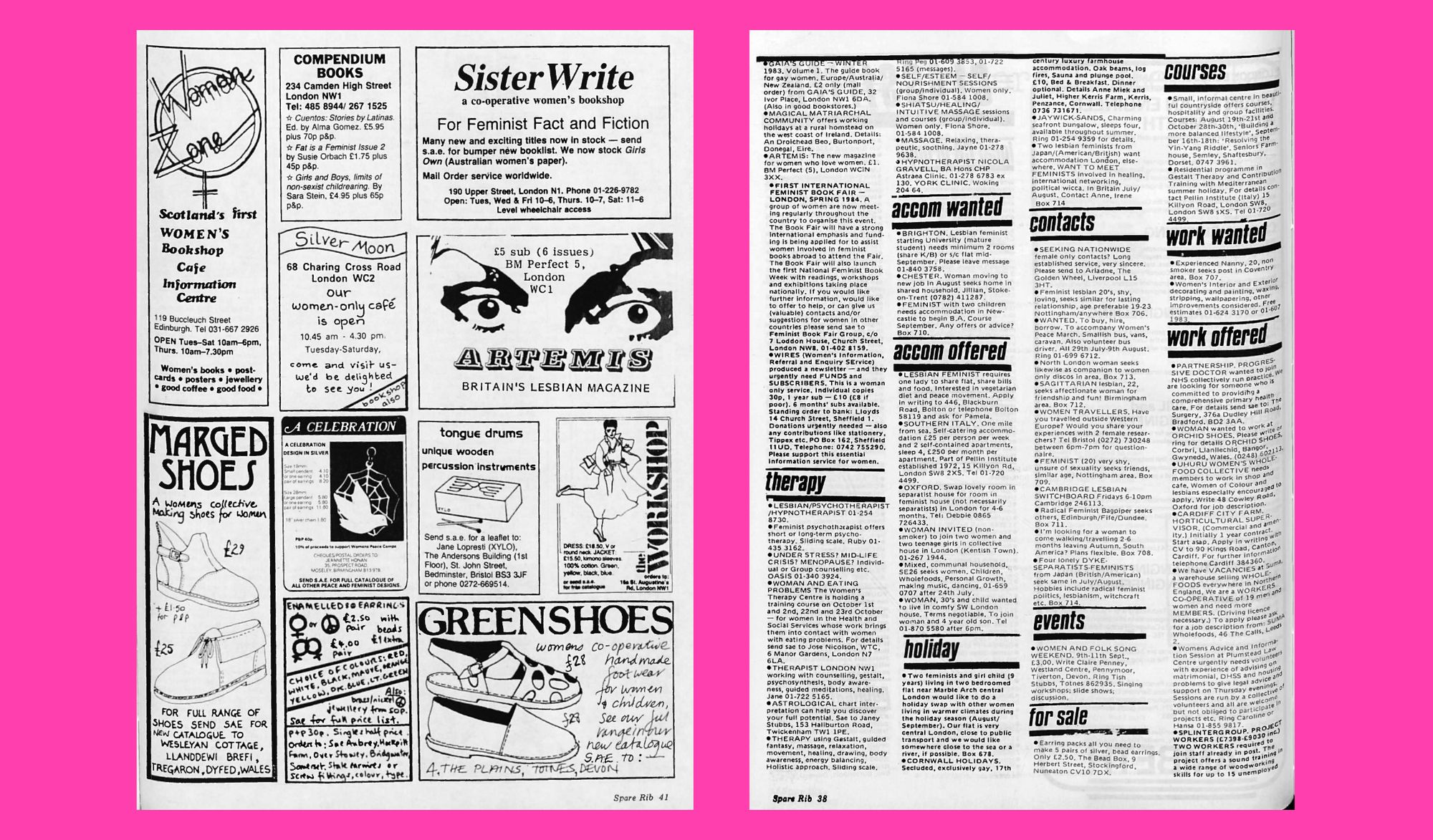
Again, this was the time of experimenting with feminist collective practices, which doesn’t always work out. These newsletters give really valuable insight into what it’s like to do feminist work. It’s really interesting to see the same problems coming up with these various groups as I see around me today, and in feminist collectives I’ve experienced. For instance, I consistently observe that questions about how to implement feminist collective working practices are constantly under consideration, very similar to how Spare Rib encountered obstacles in trying to create a magazine “for all women” and what that looked like in practice when women were at odds with each other.
These kinds of topics are usually brushed under the carpet, right? We don’t really like to talk about our conflicts. I’ve been trying to do that more and more because I feel this is a really important part of feminist practice. We need to have more conversations about how to handle conflicts.
Also, we often don’t have the tools to communicate properly with each other and say what we think. So much of female socialization is to accept what someone says to you, and then give little tiny hints and expect the other person to know what you’re thinking. There’s so much toxic behavior that women learn throughout their lives that we put on each other, and no amount of “Oh, let’s be a collective” will solve the practicalities of what that actually means to be a collective.
There’s a really amazing essay by civil rights activist and a lawyer Florynce Kennedy called Institutionalized Oppression vs. the Female, where she basically talks about how a lot of oppressed people—not just women—are used to either having a boot on their neck or their boot on somebody else’s neck. We are not socialized to think creatively or imaginatively about the in-between, and we often don’t know what it would look like to set up an environment wherein conflict is debated constructively. But there are, in fact, many guidelines that can help us. For example, Gracie Lyons’ Constructive Criticism, a 1976 best seller that came out of the socialist movement, has been used by lots of feminist collectives as guiding principles.

Particularly when you just awaken into feminism, you really wanna work with women, and it all feels so exciting. And then, because you trust the women or you’re friends with them, you don’t think, “Oh, what happens when we disagree?” You don’t set up principles together for when things go wrong, because you don’t think they will because you’re women! Janice Raymond wrote a really great book on the history of female friendship called A Passion for Friends. There’s this one chapter about feminist conflict and conflict between women, where she explains how the problem often lies in the fact that we don’t expect to disagree with other women, especially women that we’re politically involved with. When it does happen, it’s earth-shattering.
Yes, and you kind of lose faith in feminism itself!
Exactly. This is what Raymond says: the crisis becomes feminism itself! Which is so wrong. Raymond’s advice is that we need to basically expect to disagree with each other. Because it’s gonna happen!
Let’s circle back to the periodicals from the 1970s and 1980s. How did they handle conflict?
They provided a space, controlled by women, where women could come together and discuss openly and freely what concerned them. The end goal was not necessarily to resolve the conflicts. But because it was such a polyvocal, idiosyncratic, and networked infrastructure, if women didn’t agree with one newsletter, they would go off and start a new one. For example, out of a dispute in Spare Rib about anti-Zionism and anti-Semitism[2]which emerged during the 1982 Lebanon War, there emerged a Jewish periodical called Shifra, which only ran for a few issues—but I don’t think that’s necessarily a sign of failure.
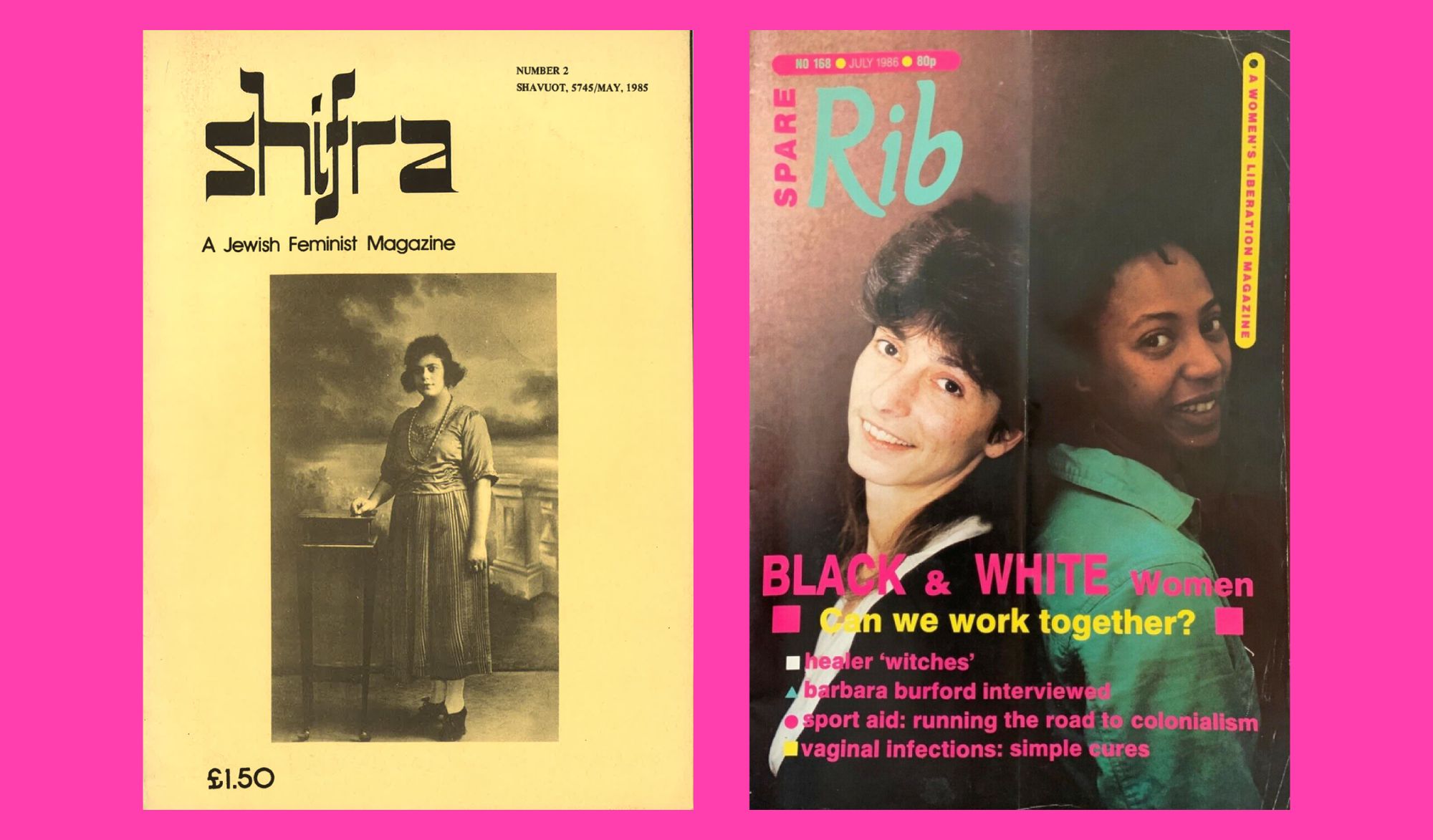
If some women disagreed with the way a discussion was unfolding, they started their own publication. I think those allowances really create this kind of discursive environment in which women had the freedom to really disagree. I wanna be careful not to over-generalize and say: “We should be able to disagree and have a discussion.” What I mean is that you have to have the infrastructure to be able to do that properly. If you’re trying to do something like that on Twitter or Facebook, it’s impossible, because it’s not set up for that purpose; it’s set up for the exact opposite goal, wherein conflict and explosive disagreement are permitted in short sharp bursts to just grab your attention, rather than for any real political reason.
A lot of the work is oftentimes just trying to find these publications, because as you mentioned, they were often published by feminist presses that went bankrupt, so many of these books and periodicals are out of print. Almost 90% of the research is actually accessing these sources. So I find it extremely interesting that your PhD generated the online resource archive Frauenkultur, opening up your research, not as a final static product, but as actually something that is living. What inspired you to start it?
Frauenkultur was a lockdown project. I didn’t really know what to do with my time because, you know, writing my thesis wasn’t happening! I had started my PhD with the intention of mapping the way in which conversations unfolded, but I always had the idea of sort of creating a reading list, a database of women’s literature—I just think some of the material is just so beautiful, and so visually interesting!
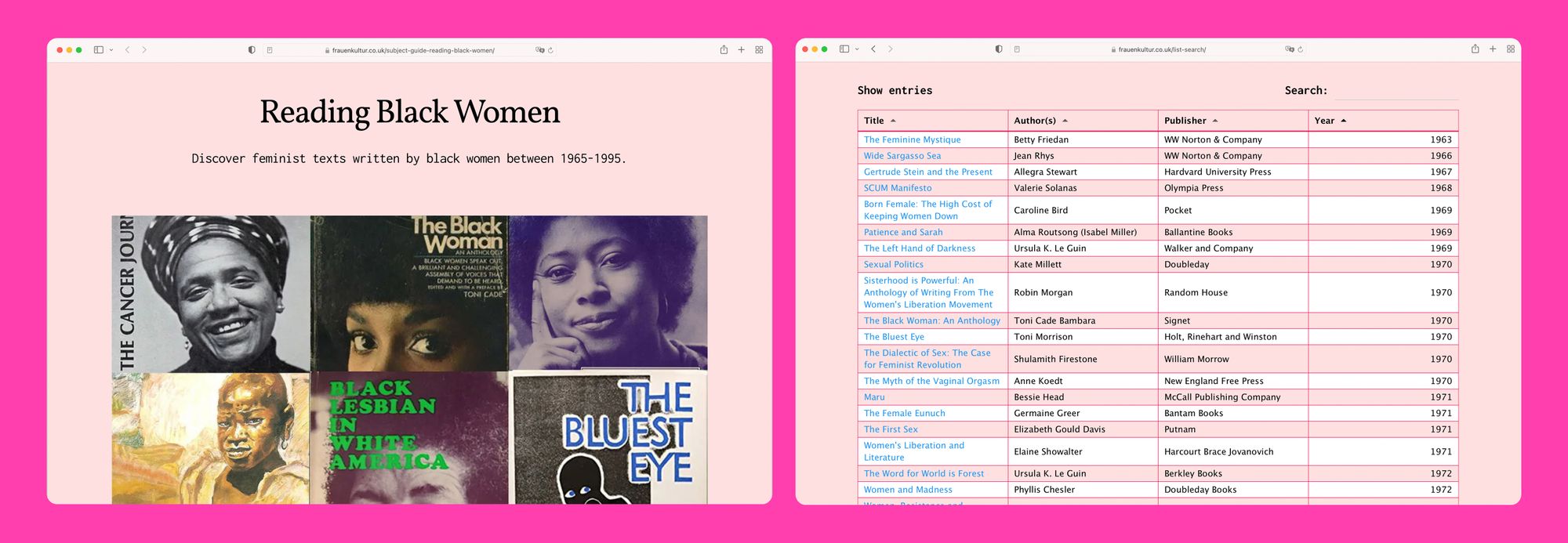
One day I bought a domain, and just did it! It was such an impulse! It took me probably about two weeks of uploading the titles every day and just getting a grip on WordPress, which I still don’t really know how to use. I haven’t really updated or maintained it for a while now. I keep writing down books that I need to add, but it’s not very streamlined. Everything’s manual, basically writing a mini little article for each book. Obviously it takes a lot of time, and if I’m really in the zone, it can take 20 minutes to half an hour to add a book. Ideally, I would like to upload all the PDFs of every single book, but there are copyright issues, even though I think feminist knowledge belongs to the public!
The point of Frauenkultur is to create as extensive a reading list of the 1970s and 1980s of the feminist movement as possible. I think there’s maybe 500 titles at the moment, and the goal is to have as many titles as possible. I also would like to create subject guides so that if you wanted to read about things like matriarchy or lesbianism, you could find the titles and use these as your starting point to search for the books yourself.
I also wanted to ask you about your illustration work, because it seems like your research often spills into your image-making. Are drawings a way for you to kind of make sense of these things?
I definitely think visually. For example, I did some social network analysis to visually demonstrate the way certain conflicts would transcend over different periodicals. I also used the Frauenkultur database to make my “Sisterhood is Powerful” poster, which I’ve wanted to do forever. I’ve also illustrated bookmarks and a coloring page of a feminist bookshelf that functions as a reading list of sorts! But much of what I do is also commissioned work that is so specific to each project at hand that it’s almost like a mind block where I don’t see my research and don’t like to have any kind of similarities, but sometimes it does. But it feels very separate just cuz it uses a separate part of my brain.
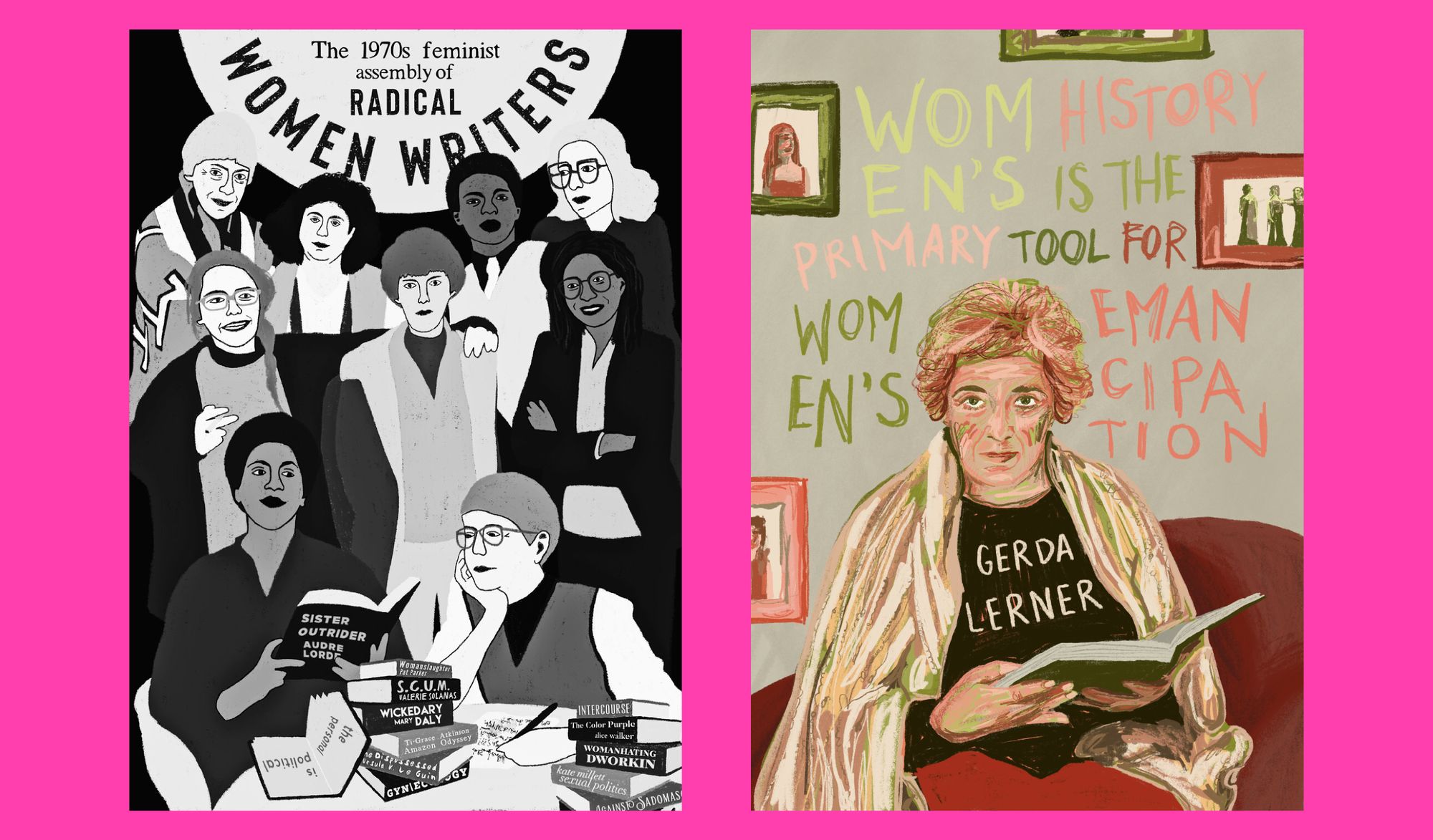
The two parts of your brain don’t seem to be separate at all! This was one of the things that made me excited to discover your work. As a trained designer, it was a massive undertaking for me to say, I’m not just a maker, but actually thinking is making and vice-versa. Sometimes we have to make things in order to think. That is also what also excites me about feminist publishing and the Women in Print Movement, is that these women—like your grandmother—were doing both things at the same time. There’s no split! And of course, the idea that certain people make, while certain people think is in reality a patriarchal capitalist colonial construct.
100%! The power of the Women in Print movement is really the idea of learning through doing. Principles of consciousness raising come into the notion that political theory comes from sharing personal experiences. I think this collective work around producing texts and material objects has a similar function.
“The feminist periodical functions as a pedagogical tool of teaching each other, but also mostly teaching yourself about something.”
In her book Feminist Literacies, Kathryn Thoms Flannery talks about feminist periodicals being like counter institutions to the university because women were teaching themselves everything. The feminist periodical functions as a pedagogical tool of teaching each other, but also mostly teaching yourself about something. You wanted to write a response to some woman talking about socialist feminism, or whether we should allow men into the movement, and in crafting that response you are actually teaching yourself, and you are learning your position on the subject. It allows for a lack of categories and categorical positioning, which we can get trapped in so often.
As someone who has been moving to different places from a very young age, I never really felt like I belonged anywhere. And although that is really disconcerting and scary, I think it’s a really good reminder that you don’t have to choose one thing—we can be multiple.
For more on India’s first feminist publishing house, we recommend reading Every Book We Do is Special, an interview with Kali for Women’s co-founder Urvashi Butalia. ↩︎
For a more detailed analysis and treatment of this topic, see Chapter 3 "Racism, Anti-Zionism, Anti-Semitism" in the forthcoming publication of Bec Wonders’ doctoral research 'Please Say More': mediating conflict through letter-writing in British second wave feminist periodicals, 1970-1990.
For additional information, see Corinne Malpocher’s 2009 doctoral dissertation Sexuality, Race and Zionism: Conflict and Debates in Spare Rib, 1972-1993 as well as Natalie Thomlinson’s 2016 book Race, Ethnicity and the Women' ’s Movement in England, 1968–1993.↩︎
Dr. Bec Wonders (she/her) is a feminist researcher, historian and writer in the field of feminist conflict, the Women’s Liberation Movement and feminist publishing networks at the Glasgow School of Art. She earned a Masters in Publishing at Simon Fraser University and co-founded the Vancouver Women’s Library. Currently, Bec runs Frauenkultur: an online archive of second wave feminist writing. Bec is also a freelance illustrator and printmaker. Her work can be found at www.becwonders.com.
Nina Paim (she/her) is a Brazilian designer, curator, and editor based in Porto. Her work spans exhibitions, workshops, and events, including Escola Aberta (Rio de Janeiro, 2012), Beyond Change (Basel, 2018), Department of Non-Binaries (Sharjah, 2018), Feminist Findings (Berlin, 2020), and, most recently, Etceteras: Feminist Festival of Publishing and Design (Porto, 2023). She has co-edited Taking a Line for a Walk (Spector Books, 2016), Design Struggles (Valiz, 2021), and Alter-Care (Esad-Idea, 2021). A three-time Swiss Design Award recipient, Nina has lectured internationally and her writing has been published by Occasional Papers (UK), Les Presses du Réel (FR), and the Korea Society of Typography (KR). In 2020, she co-founded the feminist platform Futuress.org, which she co-directed until 2023, when she launched Bikini Books, an independent publisher for design. In 2024, Nina was awarded an honorary doctorate from the London College of Communication at the University of the Arts London.



